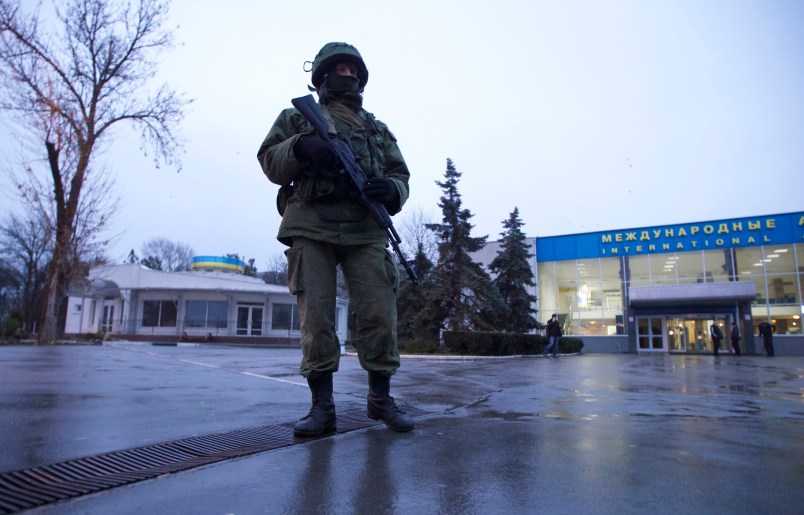The events in Ukraine have grabbed international attention but have usually been explained by recent history. With the deposition of Ukraine’s President Victor Yanukovich, and reports of people from eastern Ukraine waving Soviet, or, as it is happening in Crimea, Russian flags, while western Ukrainians clamor for Ukraine to ally itself with the European Union, it is worth taking a look at the recent events, which led to dramatic violence, in a longer historical perspective.
The tensions over whether Ukraine should lean to the West, and align itself with the European Union, or should remain tied to Russia have much deeper roots than the Soviet and post-Soviet era. In fact, the current clash between western and eastern Ukraine are a fruit of centuries of political and cultural developments that only in the 20th century forced the two parts into one Ukraine. These recent ties proved more fragile than identities built over several centuries.
RELATED: 22 Maps That Help Explain The Centuries-Long Conflict In The Ukraine
Until the second half of the 17th century the territories of what is today Ukraine, including Kiev and much of the territories east of the Dnieper River, were part of what would become in 1569 the Polish-Lithuanian Commonwealth. These eastern territories of this vast European state were porous and vulnerable to attacks, so the Polish monarchs hired Cossacks to defend these borderlands (literally that is the meaning of the Slavic word “ukraina” from which the name of the country derives). And then in 1596, the religious union in the town of Brest split a wing off the Greek Orthodox church, as it entered a union with the Catholic church creating a Uniate church, and inserted a religious element complicating the situation in the eastern territories of the vast state.
Increasingly frustrated with the compensation for their service and religious tensions, the Cossacks began to rebel. The first half of the 16th century was marked by several flare-ups, which turned into a full-fledged uprising under the leadership of Bohdan Khmielnytsky (Chmielnicki) in 1648, which caused devastation across the region, as the rebelling Cossacks reached towns of what is today western Ukraine. They controlled much of the land until in 1654 when Khmielnytsky accepted protection from Russia, and the territories under the Cossack control were effectively annexed by Russia. United, the Russian and Cossack forces attacked Poland from the east. Weakened by the simultaneous war with Sweden, Poland succumbed and in 1667 signed a treaty at Andrusovo, by which it conceded much of the eastern territories, including Kiev and territories east of the Dnieper River. The west bank of the Dnieper remained in the Polish-Lithuanian Commonwealth.
Weakened by the wars of the second half of the seventeenth century, in the eighteenth century, the once majestic and vast Polish-Lithuanian Commonwealth became a plaything in the hands of the strengthening central European powers: the Russian Empire, the Austro-Hungarian Habsburg monarchy and Prussia. In 1772, Poland was partitioned by the three powers, Russia received yet more territories in the eastern parts of Poland, as far as Kamieniec Podolski, while the Habsburg monarchy annexed western territories of what is today Ukraine, including Lviv and Halicz, known as Galicia.
The eastern territories were thus pulled closer to Russia, while western territories, were pulled to the west even more strongly than when they were under Polish rule, for now, the court in Vienna was pulling the strings and establishing policies. When the borders stabilized in 1795, the last partition of Poland, the boundary between Russian and Austro-Hungarian controlled areas of the Ukraine were to remain largely the same until 1914, the outbreak of World War I. In 1918 Poland was to reappear on the map of Europe, as would, briefly, a new country, he People’s Republic of Ukraine, which was then absorbed into the Soviet Union. By 1920, when the borders finally settled, western parts of the Ukraine became part of the new Polish Republic, while the eastern parts remained in what would become the Soviet Union.
These pulls and pushes between east and west in Ukraine are not new, their roots go back some five centuries. It does not mean that the conflict has such deep roots but rather that the long separate histories of the two parts of Ukraine have become a major destabilizing factor when once more Ukraine was to make a choice between Russia and the rest of Europe.
Magda Teter is Professor of History and the Jeremy Zwelling Professor of Jewish Studies at Wesleyan University. She was a Guggenheim fellow in 2012. She is the author of Jews and Heretics in Catholic Poland (Cambridge, 2006) and Sinners on Trial (Harvard, 2011).






